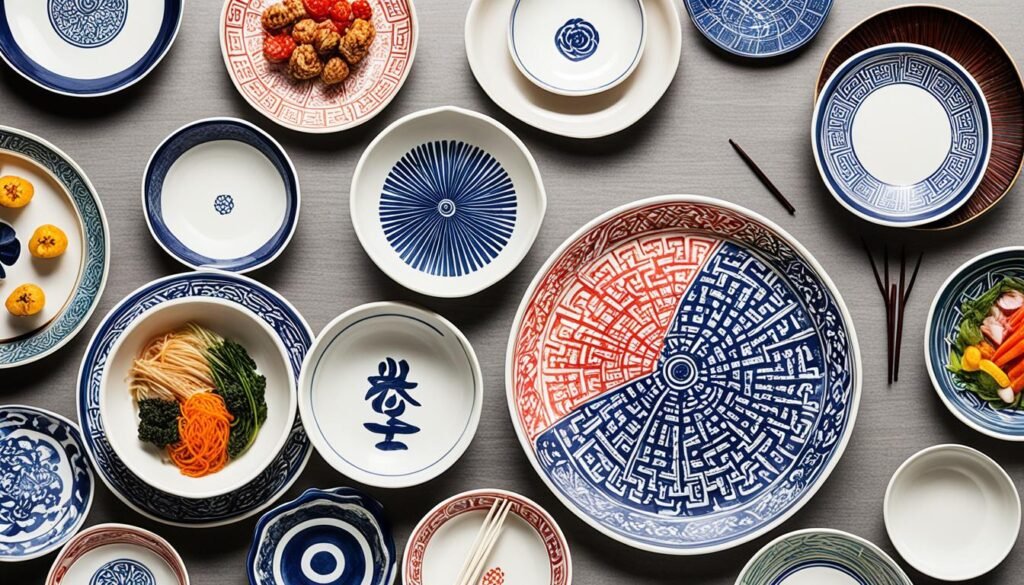
As I step into the bustling kitchen, I’m greeted by the smell of sizzling garlic and the gentle simmer of soy-infused broths. These scents take me straight to the heart of Korea. The vibrant colors of fermented vegetables and the bold mix of sweet, sour, and savory flavors show me the world of Korean cuisine.
This cuisine captivates the senses and nourishes the soul. In this article, we’ll explore the essence of the Korean kitchen. We’ll look at the rich traditions, signature ingredients, and cooking methods that make this cuisine unique. Whether you’re an expert or just starting out, get ready to be amazed by the depth and complexity of Korean flavors.
Key Takeaways
- Discover the balance of the five fundamental flavors that define Korean cuisine: salty, sweet, sour, bitter, and umami.
- Explore the unique fermented ingredients and traditional cooking techniques that shape the essence of Korean food.
- Gain insights into the regional variations and cultural significance of Korean dishes, from spicy southern specialties to the delicate court cuisine.
- Learn about the essential pantry staples, such as gochugaru (Korean red pepper flakes) and gochujang (fermented chili paste), that lend their signature flavors to Korean recipes.
- Understand the role of banchan (side dishes) and their importance in creating a harmonious and visually stunning Korean meal.
The Heart of Korean Cuisine
Korean cuisine is all about finding the perfect balance of flavors. It uses a mix of ingredients and cooking methods passed down through generations. This makes Korean dishes special, showing off the country’s rich culture.
Balancing Flavors
Korean food is known for its mix of salty, sweet, sour, bitter, and umami tastes. Chefs work hard to get this balance right. It makes the food complex and enjoyable to eat.
Traditional Cooking Methods
Korean cooking is all about using old-school methods. Things like kimchi, gochujang (red chili paste), and doenjang (fermented soybean paste) get their unique tastes from long fermentation. Pickling and slow-cooking are also key, letting ingredients blend and deepen their flavors.
The key to Korean cuisine is its balanced flavors and traditional cooking. Exploring this food culture opens up a world of tastes. You’ll see how Korean traditions make their food so special.
Essential Korean Ingredients
Korean cuisine is built on a few key ingredients. These ingredients add unique flavors and textures to many dishes. They make Korean food famous for its bold and vibrant tastes.
Rice: The Staple Grain
Rice is a big part of Korean meals. It’s short-grain and glutinous, making it perfect for many dishes. Koreans enjoy it plain or with beans, lentils, and sweet dates.
This makes the rice more nutritious and tasty. It’s a key part of korean staple foods and korean grains.
Gochugaru and Gochujang: The Signature Spices
Gochugaru (Korean red pepper flakes) and gochujang (fermented red chili paste) are key in Korean cooking. Gochugaru adds a fiery heat. Gochujang brings a rich, savory flavor to many dishes.
These spices, korean red pepper, and korean chili paste, are crucial for Korean flavors. They make Korean food bold and vibrant.
The korean rice, gochugaru, and gochujang are essential for Korean cooking. Learning to use them well is the first step to making authentic Korean dishes.
Korean kitchen: The Cornerstone of Korean Meals
The Korean kitchen is at the heart of traditional Korean food. It’s a space designed for making the country’s famous meals. These meals have a balance of rice (bap), soup or stew (guk or jjigae), and small side dishes called banchan.
This way of setting up meals makes sure each dish goes well with the others. It creates a complete and enjoyable dining experience. The banchan can be anything from pickled veggies to savory meats. This lets Korean meals fit what each person likes and needs.
| Key Components of a Korean Meal | Description |
|---|---|
| Rice (Bap) | The staple grain in Korean cuisine, often served in a steaming bowl as the foundation of the meal. |
| Soup or Stew (Guk or Jjigae) | A savory and nourishing accompaniment to the rice, providing a balance of flavors and textures. |
| Side Dishes (Banchan) | A variety of small dishes, ranging from pickled vegetables to meat-based preparations, that add diversity and complementary flavors to the meal. |
The korean meals structure is built on the korean kitchen. Here, each dish is carefully prepared. From seasoning to cooking techniques, the korean cuisine structure shows the deep culinary traditions of Korea.
Kimchi: The Iconic Fermented Side Dish
Kimchi is a key part of Korean food and culture. It has been made for over a thousand years. People in Korea use fermentation to keep vegetables like napa cabbage and radish fresh.
Kimchi-making is a special event for families and communities. They come together to make this dish for the coming year. It’s a way to share and preserve tradition.
History and Cultural Significance
Kimchi is known for its unique taste and health benefits. It’s a big part of Korean food and identity. The recipe has changed over time, with each area adding its own twist.
This shows the strong link between Korean food and culture. It’s a way to connect with the past and celebrate diversity.
Varieties and Flavors
Kimchi can taste different because of the ingredients and how it’s made. Some are sweet, others sour, and some spicy. This variety lets people choose their favorite flavors and pairings.
There are many types of kimchi, like napa cabbage, radish, and cucumber kimchi. Each one offers a new taste adventure. It shows the creativity in Korean cooking.
Kimchi is more than just a side dish. It’s a key part of Korean meals, adding flavor to many dishes. The tradition of making kimchi together is even recognized by UNESCO.
This tradition shows how important kimchi is in Korean life. It brings people together and preserves a cultural heritage.
The Art of Banchan (Side Dishes)
In Korean cuisine, banchan, small side dishes, are key to a great meal. They add a mix of textures, colors, and tastes that go well with the main dish. This makes every meal complete and enjoyable.
Variety and Balance
Banchan includes stir-fried veggies, pickled radishes, savory meats, and fermented soybeans. Each dish has its own unique taste. This mix ensures a meal is balanced and tasty, with each dish adding its own flavor.
Seasonal and Regional Influences
The types and tastes of banchan change with the seasons and vary by region in Korea. Some are eaten more in summer, others in winter. Different areas have their own special banchan. This shows how Korean food connects with nature and culture.
The new cookbook “Discover Korean Kitchen: Flavors & Techniques” will share over 60 korean banchan recipes. This 192-page book is the first in the U.S. to focus on korean side dishes. It highlights their importance in korean meal structure, korean seasonal eating, and korean regional cuisine.
Korean Cooking Utensils and Kitchenware
The Korean kitchen is filled with unique tools and kitchenware for making traditional dishes. You’ll find everything from the versatile tteok-kal pan to the special kimchi refrigerator for fermenting foods. These items are made to bring out the best flavors and textures in Korean cooking.
Other key korean kitchen tools include the dolsot stone bowl for sizzling rice, metal chopsticks and spoons for eating, and the jeolgu mortar and pestle for grinding spices. These tools are not just useful; they carry deep cultural meaning. They show the long history of Korean cooking.
| Korean Kitchenware | Description | Price Range |
|---|---|---|
| Neoflam FIKA Cookware | Durable and heat-retaining cookware | ₩40,000-₩50,000 (Approx. $36.22-$45.37) |
| Neoflam Retro-T Pot-ware | Stylish and versatile pot-ware collection | ₩50,000-₩60,000 (Approx. $45.27-$54.31) |
| 55 BRAND Bonbon Silicone Utensils | Colorful and heat-resistant silicone kitchen tools | ₩5,000-₩15,000 (Approx. $4.52-$13.57) |
| Modori Sodam Cookware Set | Complete cookware set for Korean cuisine | ₩220,000 (Approx. $198.98) |
| PN Poongnyun MONO Lunch Box | Stylish and practical lunch box for Korean meals | ₩65,000 (Approx. $58.79) |
| Hanssem Wide Bloom Dish Rack | Elegant and functional dish drying rack | ₩79,900 (Approx. $72.27) |
| KwangJuYo Bell Cup | Traditional Korean ceramic cup for drinks | ₩15,000-₩30,000 (Approx. $13.57-$27.13) |
From korean cooking equipment to korean kitchenware, these tools are key to making Korean food special. They help bring out the true taste and spirit of Korean cuisine. They also show the country’s rich food traditions.

Korean BBQ: Grilling Traditions
Korean BBQ, or gogi-gui, is a favorite way to enjoy food that highlights the country’s grilling skills. At the core of Korean BBQ are samgyupsal (thick-cut pork belly) and galbi (marinated beef short ribs). These are grilled right at your table on a special grill. The sizzle, the smell of smoke, and the fun of making your own meal make it a unique and social dining experience.
Samgyupsal and Galbi
Samgyupsal, or grilled Korean pork belly, is a top choice for korean bbq. It’s often grilled without marinating. Galbi, on the other hand, means ribs, usually beef short ribs. They’re made by cutting the ribs thin and marinating them in a mix of sweet and savory sauce.
Sauces and Marinades
The taste of korean bbq isn’t just about the meat. It’s also about the korean bbq sauces and korean bbq marinades. These ingredients are key to making the food taste great. Sauces like ssamjang (a mix of savory, spicy, and sweet) and gochujang-based marinades add a unique flavor to the meats.
This mix of grilled meats and special sauces and marinades is what makes Korean BBQ so special. It creates bold and balanced flavors.
Korean Tableware and Dining Etiquette
Korean cuisine is famous for its bold flavors and deep cultural traditions. These include the art of setting the table and dining etiquette. Traditional Korean tableware, like metal chopsticks and ceramic bowls, shows the country’s heritage. They are not just for eating but also carry cultural significance.
The way korean tableware is arranged on the table and the rules of korean dining customs create a respectful and shared dining atmosphere. This is key to Korean meal traditions. Serving elders first and using communal dishes shows respect for hierarchy and community. These practices highlight the importance of harmony in Korean culture.
- Korean culture values respect for elders at the dining table, where the eldest family member typically initiates the meal.
- A tradition when enjoying a Korean meal is to start by tasting soup or stews to prepare the taste buds for the subsequent flavorful dishes.
- The Korean dining etiquette emphasizes using chopsticks for dishes and spoons for rice and soup, without ever using chopsticks to poke, stab, or point at food.
- Holding and lifting rice or soup bowls while eating is considered impolite in Korean dining customs.
| Korean Dining Etiquette | Traditional Korean Tableware |
|---|---|
| Sharing dishes is crucial, and individuals are encouraged to take only what they need from shared plates to ensure everyone enjoys the meal. | Metal chopsticks and spoons, ceramic bowls, and elaborately designed serving dishes. |
| Calmly eating and thoroughly chewing food, without rushing through the meal or eating with an open mouth, is emphasized. | The arrangement of these elements on the table reflects the country’s rich cultural heritage. |
| Distractions such as using phones, watching TV, or reading magazines at the table are discouraged, emphasizing the importance of enjoying food and company. | These traditional korean tableware pieces serve both functional and cultural purposes. |
By understanding and embracing these korean dining customs, you can fully immerse yourself in the communal and convivial experience that is central to Korean meal traditions.

Community and Sharing in Korean Food Culture
At the heart of Korean food culture, community and sharing are key. Meals are often set up for everyone to share. This way, people enjoy many dishes together, making it a time for laughter and connection.
Sharing food with others is a big part of Korean life. It’s not just about eating. It’s about building strong bonds with family and friends. Giving seasonal foods to those close to us shows we care deeply.
| Aspect of Korean Food Culture | Significance |
|---|---|
| Communal Dining | Meals are often shared, with multiple dishes placed in the center of the table for everyone to enjoy, promoting conversation and togetherness. |
| Gifting of Seasonal Foods | Giving friends, family, and co-workers seasonal foods and snacks is a way to strengthen social bonds and express care. |
| Importance of Community | Food is seen as a means of nourishing not just the body, but also the soul and fostering meaningful relationships. |
Korean food culture is more than just eating. It reflects the values of community, sharing, and connection. By diving into this tradition, we learn about the ties that connect the Korean people.
Seasonal and Activity-Based Eating
Korean cuisine changes with the seasons, offering different dishes and ingredients at various times. In the hot korean summer foods, people enjoy cool dishes like kong-guksu and bingsu. These korean cold dishes help beat the summer heat and show how Korean food adapts to nature.
When it gets colder, Korean food turns to warm, nourishing dishes. Korean stews and soups like kimchi-jjigae and sundubu-jjigae become popular. Tteokbokki and other korean comfort foods warm people up during winter. These dishes, eaten with family and friends, highlight the strength and creativity in korean seasonal eating.
Summer Dishes
- Kong-guksu: Chilled soybean noodle soup
- Bingsu: Icy, fruit-flavored shaved ice dessert
Winter Warmers
- Kimchi-jjigae: Kimchi stew
- Sundubu-jjigae: Soft tofu stew
- Tteokbokki: Spicy rice cakes

Conclusion
Korean cuisine is full of vibrant flavors and cultural traditions. It’s a world that food lovers around the globe find fascinating. From the basics like rice and fermented sauces to the way people eat together, Korean food offers a rich experience.
By diving into this korean cuisine summary, you’ll find new dishes to try and appreciate the art and history behind them. You’ll see how food brings people together and connects them to their culture.
If you love Korean food or are just starting to get into it, this article will help you on your own food adventure. Korean dishes are not only tasty but also healthy and full of cultural heritage. They offer a unique and rewarding experience for anyone who tries them.
As you explore the amazing flavors and traditions of Korean cooking, may you find inspiration and a deeper connection to the world of food. Korean cuisine is a beautiful part of global culinary excellence.
FAQ
What are the key characteristics of Korean cuisine?
What is the role of fermentation in Korean cooking?
What are some of the essential ingredients in Korean cooking?
How is a traditional Korean meal structured?
What is the significance of kimchi in Korean cuisine?
What is the role of banchan in Korean meals?
What is the significance of Korean BBQ and its associated flavors?
How does Korean cuisine reflect the changing seasons?
The Baffls Team (info@baffls.com)
#KoreanCuisine #CookingTechniques #KoreanFlavors
Disclosure: This post contains affiliate links. If you make a purchase through these links, I may earn a commission at no additional cost to you. We only recommend products or services that I personally use and believe will add value to my audience. Your support helps keep this content free for everyone. Thank you for your support!
Prices and discounts noted at the time of publication Tuesday August 13, 2024. They may have been changed without notice by the retailer at the time you view this page.








